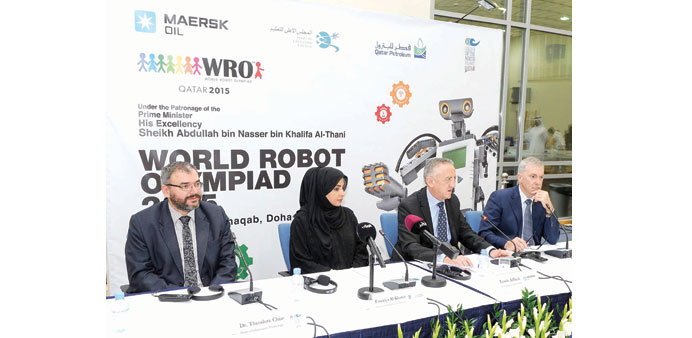From left: WRO 2015 organisers, Dr Theodore Chiasson, Dean of IT at CNA-Q; Fawziya al-Khater, Director of the Education Institute at SEC; Lewis Affleck, Managing Director of Maersk Oil Qatar; and Dr Ken MacLeod, President of CNA-Q at the launch yesterday.
By Anand Holla
In less than a month from now, Qatar, for the first time, will host the 12th World Robot Olympiad (WRO). Maersk Oil Qatar and College of the North Atlantic Qatar (CNA-Q), in partnership with the Supreme Education Council (SEC), officially launched the 2015 WRO to much excitement yesterday.
Following the Qatar National Robot Olympiad (QNRO) finals scheduled for October 30 and 31, the 2015 WRO – featuring 3,000 of the world’s brightest robotics students from Qatar and around 55 other countries – will unfold at the 6,000sq m Al Shaqab Indoor Arena from November 6 to 8.
Last week, Community did a cover story on the training in the use of robotics programming being taken by hundreds of teachers in Qatar, in preparation of the championship. With the launch, Dr Theodore Chiasson, Dean of Information Technology at CNA-Q, spoke about what’s in store.
What is the most challenging part with the world coming down to Qatar for the WRO?
Any event of this size would have its challenges. Our biggest challenge was to find a big enough venue. So, last November, we heard about the Al Shaqab equestrian facility and took a tour of it. It’s actually kind of perfect for the event. They have an indoor arena that’s 100m by 60m and it has sand on it. But they scrape it down to the bare concrete to host events that aren’t related to horses. We decided to rent the venue for 11 days and holding our national finals on one weekend and then the world finals on the following weekend. So we will do all the set-up for the national finals and use it as a dry run for the world finals so as to get rid of any problems out of the venue that we may encounter during our national finals.
So the venue is well-suited to hold a robotics event of this scale?
The venue is beautiful. They have stringent light control that’s really helpful for robotics. As they carry out a lot of live, HDTV filming in the venue, the original design had slots in the roof where the sun could come in. Those slots are now covered and we, therefore, have a very controlled lighting environment that has ambient light coming in but no direct sunlight. The conditions are just right for robotics. It’s very exciting.
In three years since its launch, the GO ROBOT programme has reached more than 8,000 students in Qatar and more than 1,000 teachers have participated in robotics training sessions. Does the same upward curve apply for QNRO, which is the culmination of GO ROBOT?
This is the fifth year of QNRO, and each year, it has grown. From 69 teams to 110 to 155 to 217 to nearly 400 teams that have signed up for this year’s event. When things double in size, they more than double in logistics. Just the QNRO finals are a challenge. Then, we have the WRO.
What sort of competitions has been specially devised for the WRO?
Since we are the host country, we design the games that are used throughout the world for the local, regional, national competitions, and then the world finals. The theme for 2015 WRO is Robot Explorers. Of the various levels of competition, the elementary category is called Pearl Diving, in tune with Qatar’s history and for this, robots must dive into the water and get back up within 30 seconds with pearls. The middle school has Treasure Hunt and the High School has Mountaineering. In the open category, students participate in a booth where they present a project.
How will WRO coming to Qatar change things for robotics in this country?
First off, we get to send more than 30 teams into the WRO finals because we are the hosts. We also have the potential for everybody to look around and see what’s happening. When nearly a dozen top teams of Qatar went to various WRO finals, their appreciation for the level of competition of the WRO finals grew. For instance, one team here solved the challenge completely in 1.10 minutes when they had 1.20 to solve it. They thought they had done well. In WRO finals, the top team solved it in 45 seconds. So it really opens their eyes to what can be done with robotics.

